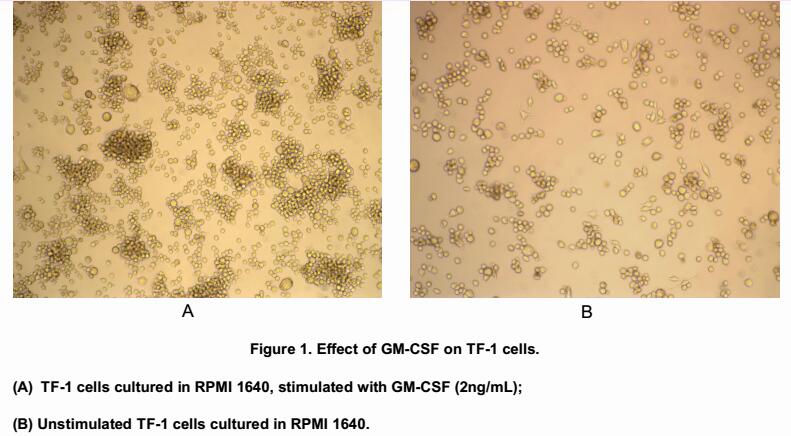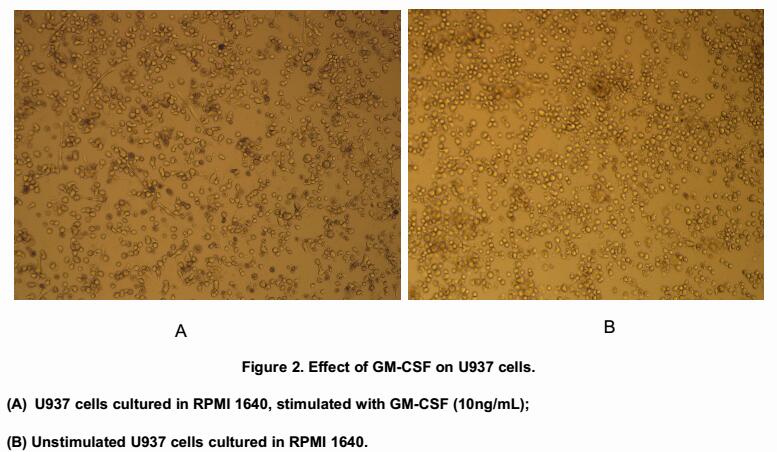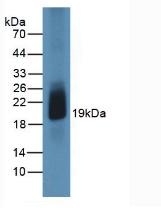Active Colony Stimulating Factor 2, Granulocyte Macrophage (GM-CSF) 

CSF2; GMCSF; Sargramostim; Molgramostin; Granulocyte-Macrophage Colony Stimulating Factor
- UOM
- FOB US$ 216.00 US$ 540.00 US$ 1,080.00 US$ 3,240.00 US$ 8,100.00
- Quantity
Overview
Properties
- Product No.APA045Hu61
- Organism SpeciesHomo sapiens (Human) Same name, Different species.
- ApplicationsCell culture; Activity Assays.
Research use only - DownloadInstruction Manual
- CategoryCytokineHematology
- Buffer Formulation20mM Tris, 150mM NaCl, pH8.0, containing 1mM EDTA, 1mM DTT, 0.01% SKL, 5% Trehalose and Proclin300.
- Traits Freeze-dried powder, Purity > 95%
- Isoelectric Point5.2
Sign into your account
Share a new citation as an author
Upload your experimental result
Review

Contact us
Please fill in the blank.
Activity test

TF-1, the human erythroleukemia cell line,provides a good system for detecting the activity of GM-CSF for it is a cell line of immature erythroid origin that completely depends on interleukin 3 (IL-3) or granulocyte-macrophage colony-stimulating factor (GM-CSF) for long term growth. As reported, GM-CSF was also able to induce differentiation of human monoblastic leukemia cell line U937. In house data was obtained by the following experiment: TF-1 cells and U937 cells were incubated in the presence of various concentrations of rhGM-CSF, then cells were observed by inverted microscope everyday .
Cell proliferation of TF1 cells after incubation with GM-CSF (10ng/mL) for 3 days was shown in Figure 1.

Cell differentiation of U937 cells after incubation with GM-CSF (10ng/mL) for 5 days was shown in Figure 2.
Usage
Reconstitute in 20mM Tris, 150mM NaCl (pH8.0) to a concentration of 0.1-1.0 mg/mL. Do not vortex.
Storage
Avoid repeated freeze/thaw cycles. Store at 2-8°C for one month. Aliquot and store at -80°C for 12 months.
Stability
The thermal stability is described by the loss rate. The loss rate was determined by accelerated thermal degradation test, that is, incubate the protein at 37°C for 48h, and no obvious degradation and precipitation were observed. The loss rate is less than 5% within the expiration date under appropriate storage condition.
Increment services
-
 BCA Protein Quantification Kit
BCA Protein Quantification Kit
-
 Molecular Mass Marker for Protein
Molecular Mass Marker for Protein
-
 Monoclonal Antibody Customized Service
Monoclonal Antibody Customized Service
-
 Polyclonal Antibody Customized Service
Polyclonal Antibody Customized Service
-
 Protein Activity Test Experiment Service
Protein Activity Test Experiment Service
-
 Electrophoretic Mobility Shift Assay (EMSA) Experiment Service
Electrophoretic Mobility Shift Assay (EMSA) Experiment Service
-
 Buffer
Buffer
-
 Lentivirus Packaging Experiment Service
Lentivirus Packaging Experiment Service
-
 Adenovirus Packaging Experiment Service
Adenovirus Packaging Experiment Service
-
 Real Time PCR Experimental Service
Real Time PCR Experimental Service
-
 Spike RBD Protein (S-RBD)
Spike RBD Protein (S-RBD)
-
 Protein G
Protein G
-
 Protein A
Protein A
Citations
- Effects of 900-MHz Microwave Radiation on γ-Ray-Induced Damage to Mouse Hematopoietic SystemPubMed: 20391130
- Safety and efficacy of the peptide-based therapeutic vaccine for HIV-1, Vacc-4×: a phase 2 randomised, double-blind, placebo-controlled trialPubmed:24525316
- Genetic and immunogenicity analysis of porcine circovirus type 2 strains isolated in central ChinaPubmed:29305646
- Activated Macrophages of Monocytic Origin Predominantly Express Proinflammatory Cytokine Genes, Whereas Kupffer Cells Predominantly Express Anti …
- Quantitative and Qualitative Characterization of Phagocytic Activity of Macrophages of Bone Marrow and Fetal OriginPubmed: 31183654
- The regulatory role of SFRP5/WNT5A axis in allergic rhinitis through inhibiting JNK pathway activation and lowering mucin generation in human nasal?¡33285209
- Co-delivery of PSMA antigen epitope and mGM-CSF with a cholera toxin-like chimeric protein suppressed prostate tumor growth via activating dendritic cells and?¡33612342








